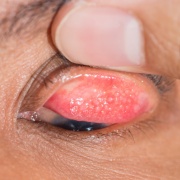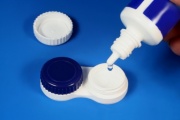Contents |
Understanding and Avoiding Contact Lens Complications: Polymegathism, Neovascularization and the Endothelial Pump
Introduction
Conjunctivitis is an inflammation of the transparent membrane that covers the whites of the eyes and lines the insides of the eyelids.
Giant papillae are large nodules that form on the inside surfaces of the eyelids, usually as a result of an inflammation from protein deposits on contact lenses, a sensitivity to the lens material itself, or a mechanical irritation from the lens edges.
Giant papillary conjunctivitis (GPC) is a type of allergic reaction to the triggers listed above. It is seen almost exclusively in contact lens wearers and more common with daily-wear soft lenses (those meant to be worn during the day only, and replaced every six months to a year), and frequently in patients who do not follow cleaning and lens care procedures. GPC is also seen more frequently in patients wearing soft lenses rather than those wearing rigid gas-permeable (RPG) lenses.
Symptoms and signs may include thick, ropy, mucous discharge, fluctuating vision due to the rapid buildup of mucous on the lenses, and excessive contact lens movement on the eye. The excess movement is because the lenses are somewhat sticky and move with the eyelids more than would normally be desired. Most patients with GPC also experience various levels of itching.
When the upper eyelid is everted (flipped inside out) there will be large cobblestone-like structures that are secreting mucous. (See photo at left)
GPC is usually seen in contact lens wearers who have been in lenses for months or years; it is also seen much more frequently in patients whose lens cleaning and care habits are not optimal. It is easy to become complacent about lens care compliance when no problems have arisen over a period of time.
In severe cases of GPC, the papillae can produce so much mucous so quickly that even a brand new lens inserted into the eye will immediately begin to move with the lid and be covered with discharge. At this point, contact lens wear is almost impossible.
Treatment
First: replace the lenses. Fresh, new lenses have no protein deposits to stimulate GPC.
Second: review all lens care and cleaning procedures, including mechanically rubbing the lenses with a surfactant cleaner every time they are removed from the eyes.
Third: refit with a lens material that is less prone to depositing, such as a silicone hydrogel or an RGP.
Fourth: if the first three haven’t been successful, discontinue all contact lens wear until the GPC resolves.
It should be clear that GPC is generally a complication of non-compliance; patients who have become lax in caring for their lenses on a daily basis are much more likely to develop it.
Review of lens care and cleaning regimens is important. Most cases of GPC are seen in patients who have successfully worn contact lenses for some time. When a patient has neglected to mechanically clean the lenses on removal from the eye and hasn’t perceived any problems as a result, that patient will usually begin to believe that lens cleaning is not particularly important. If that patient doesn’t return to the eyecare practitioner’s office on a regular basis, (as patients who buy lenses over the internet often neglect to do) it is a perfect setup for GPC to get a foothold.
In mild cases of GPC, switching to a lens modality that is daily-disposable is the best option, to provide a fresh lens each day. At the very least, a planned-replacement schedule of a new lens is recommended.
Switching to a lens material less prone to protein deposits is also helpful; the conjunctiva is responding to the presence of those deposits, so reducing the incidence and size of them is helpful in managing GPC.
If caught early and the patient is switched to replaceable lenses, it is possible for GPC to never fully develop; GPC is much less common in patients who replace their lenses frequently. If a contact lens wearer cleans and cares for the lenses properly and replaces them as directed, GPC will probably be prevented.
In moderate to severe cases, GPC can prevent the patient from wearing contacts at all, at least until it is well-controlled. All contact lens wear should be discontinued while the GPC resolves on its own; this may take weeks or even months, but short courses of topical medications may be given to calm the inflammation response and get the patient back into lenses if desired. Newer lens materials and a daily-disposable replacement schedule will help prevent a recurrence.
Summing Up
Preventing GPC from developing at all is the best outcome in all senses.
Some patients are more prone to this complication than others, and will develop it in response to even small amounts of protein on their lenses. During follow-up visits, one of the things the eyecare practitioner looks for is any sign of less than pristine clarity of the lenses.
Therefore, patients should return to their practitioner’s office for follow-up visits and on a regular basis thereafter. That said, it should be understood that GPC does not usually happen overnight, but is a gradual process of the conjunctiva lining the insides of the lids adapting to what might be insignificant lens awareness in most patients.
GPC can be the result of long-term consequence less-than-perfect lens cleaning and care, which long-time contact lens wearers are more likely to be somewhat complacent about. It is easy to settle in to a lens care routine that seems to work, even though it may be one that isn’t what they were initially taught.







